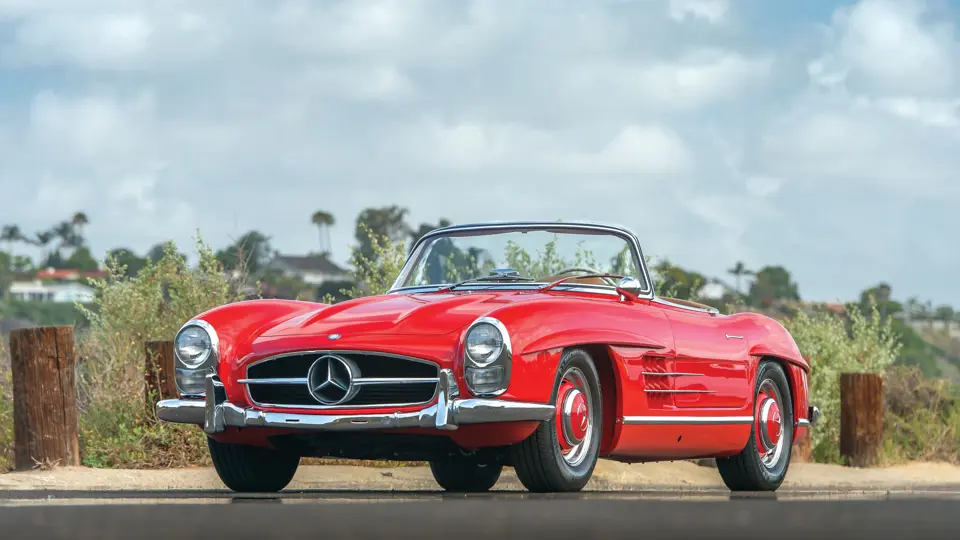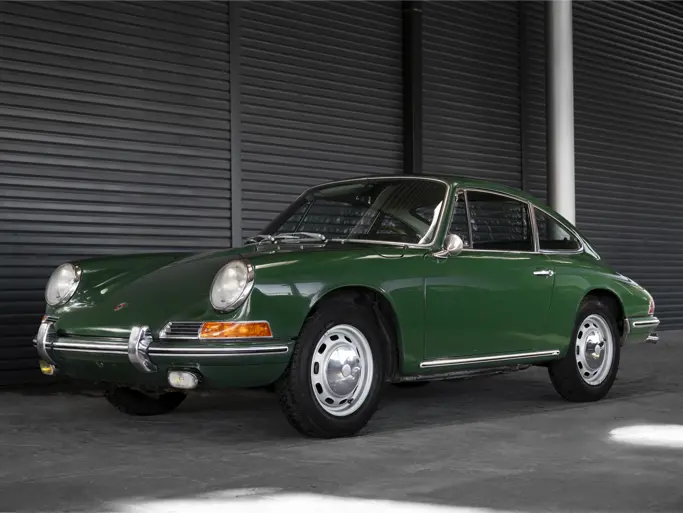Although Mercedes’ classic 300SL ‘Gullwing’ Coupe is rightfully recognized for its beautiful appearance and sporting pedigree, by the end of the model’s three-year production run, many drivers agreed that the car left much to be desired in terms of ergonomics and ease of use. Addressing these numerous criticisms, Daimler-Benz unveiled a successor to the Gullwing at the 1957 Geneva Motor Show, a new convertible iteration dubbed the 300SL Roadster. The roadster’s redesigned space frame cleared the way for conventional doors, a change that not only made entering and exiting the car much easier, but also allowed for wind-up windows, a feature that provided ventilation sorely lacking in the Gullwing’s notoriously hot cabin.
While transforming the platform into a convertible required structural reinforcement that made the 300SL slightly heavier than its predecessor, performance was essentially the same due to the use of a competition-style camshaft, which boosted the engine’s power output by 20-hp. Handling was improved with the implementation of a lower pivot-point on the rear swing-axle suspension, a modification that was further bolstered by a wider track and fatter tires. This more predictable handling reduced the 300SL’s tendency to oversteer in fast corners.
By the time production ceased in 1963, only approximately 1,858 examples of the 300SL Roadster were built, and the sublime convertible remains an elegant and revered ancestor of the vaunted lineage of SL road cars that followed.
In 1960, if you asked any sports car enthusiast what they personally considered to be the best, most desirable sports car in the world, the chances were considered better than even that the answer would be the Mercedes-Benz 300SL – most without hesitation. Many in the Ferrari camp would differ in a vociferous manner of indignation, but these personal preferences were most likely to be determined by the prestige and reputation of the company. In 1960, the Ferrari marque had officially been part of the scene for less than 15-years, so they were in their early formative years versus the 1886 beginnings of the vaunted Star and Laurel. Racing heritage was also quite important and there is little doubt that this period of automotive history saw the building of prestige with a successful racing department. There was no incorrect answer, but the 300SL took a backseat to no one.
The Mercedes-Benz 300SL was a good car made better by constant refinement and attention to detail. Surface changes to the car were few, and few would quarrel with the businesslike styling of the 300SL. The lines were considered to be subtle, but left no doubt as to the car’s purpose. It signified power and speed as few other designs of the era would and the appeal seemed to be equally shared by men and women. Priced from $11,000 and clearly aimed at the all-important American market, the 300SL Roadster was immediately adopted by the world’s business, entertainment and social elite.
The interior appointments of the 300SL were in keeping with the car’s five-figure price tag of the time, and this successfully separated this model from the category of stark functionalism that fit the die-hard sports car enthusiast’s ideas of what a sports car should be. There were few automobiles in the world that could match the feeling of confidence one received from driving this mighty car. Any driver, novice or pro, could wring enough performance from the car to impress his friends, and better yet, be secure in the knowledge that not many cars on the road were better constructed or could cover ground faster with as much built-in safety.
This striking 1960 300SL benefits from caring owners, high-quality maintenance by respected specialists, and a carefully maintained restoration that continues to present well.
Notable among its former owners is Ned Stone Tanen, the legendary Hollywood studio executive, who acquired the 300SL in late 1987 at the pinnacle of his career. A driving force at MCA Records, which signed Neil Diamond, Elton John, and Olivia Newton-John; Mr. Tanen went on to head production of such hits as American Graffiti, Jaws, The Deer Hunter, The Blues Brothers and Animal House (among many others) at MCA’s Universal division. Mr. Tanen left Universal in the early 1980s to form Channel Productions, from which John Hughes’ “Brat Pack” classics Sixteen Candles, St. Elmo’s Fire and The Breakfast Club emanated. Going from strength to strength, Mr. Tanen became president of Paramount’s movie division in 1985 and under him, yet another succession of hits followed including Ferris Bueller’s Day Off, Fatal Attraction and Children of a Lesser God. Considering that Mr. Tanen purchased this elegant roadster while at the apex of his career, one might view the car as a benchmark of his finest hour.
Mr. Tanen clearly enjoyed his SL and he applied sincere and meticulous care of this Mercedes-Benz during his ownership. His stewardship saw the first major round of investment having Hjeltness Restoration (recognized specialists in 300SL restorations) of Escondido, California, refinish the exterior paint and repair both the fuel-level gauge and heater. In 2007, the respected European-car specialists at West Los Angeles’ Sehmi Motors replaced the trunk and tonneau-cover seals, repaired the radio and clock, rechromed the bumpers, tuned the engine, repaired the fuel pump, and replaced the tie rods. Next in 2008, Van Nuys Sports Cars of Sherman Oaks cleaned the fuel injectors, reconditioned the intake manifold, and replaced the water pump. After Mr. Tanen’s passing in 2009, his remarkable automobile collection was gradually sold by his estate and the 300SL, along with a Shelby 289 Cobra and Ferrari 275 GTB, were purchased by a highly selective California collector in the Montecito area where it continued to be regularly tended to by renowned veteran technician, Jack Bianchi.
In addition to ensuring that the 300SL remained in strong mechanical condition, ever prepared for the always-possible arrival of its owner, Mr. Bianchi undertook a handful of minor measures to further bolster the car’s authenticity. These steps included sourcing an elusive, proper, white factory steering wheel with the correct horn ring to replace the Nardi wheel that Mr. Tanen had preferred. The car’s originality is further enriched by the presence of all of its original manuals and warranty cards, including the original tire warranty, as well as a complete toolkit. Custom luggage is fitted for the trunk.
The 300SL was acquired by the consignor in August 2012. This charming 300SL is mechanically correct and is an example that runs its correct drivetrain - one that certainly offers strong cosmetic quality and can be enjoyed as a capable driver. The radio is the preferred Becker Le Mans unit, and this machine assures its next owner ease of use and luxurious performance as one of Mercedes’ most esteemed open-top models. An arresting example of Mercedes’ classic SL Roadster that is sure to turn heads wherever it goes, this car would beautifully complement the finest of collections.
This 1960 300SL clearly continues to benefit from excellent care and maintenance, representing a strong and highly enjoyable touring and event car. With Mercedes-Benz, nothing is left to chance. Throughout the manufacturing process, everything in every Mercedes-Benz is constantly checked and rechecked. That is the essence of quality. And that is one of the reasons Mercedes-Benz is the car of connoisseurs.



 | Santa Monica, California
| Santa Monica, California


